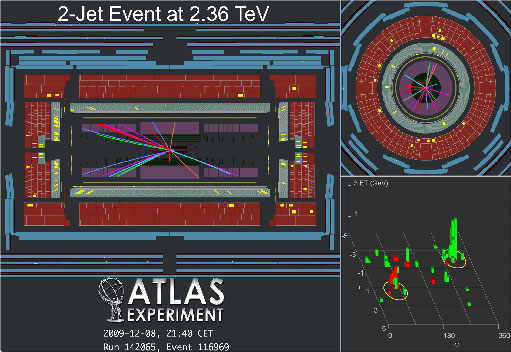
ATLAS e-News
23 February 2011
What a year for ATLAS, from despair to joy!
14 December 2009

More than a year finally since this unfortunate incident on the LHC that put us down in desperation.
Yes we were ready to get the best out of the first recorded events in 2008 but it was not our time yet. Since then, did we just wait for the arrival of the cavalry that was promised to be there soon, then almost there, and at last YES!
No of course we did not wait! We were ready but like any America Cup sailing boat, there is always something to improve, tune, change, repair and test to be ready when the race starts. So ATLAS physicists worked hard. They worked days and nights during this full year to get ATLAS ready in full glory for the first collisions of the LHC.
From the 2008 “splash” and single beam events, that allowed a first look at the timing and at the global behavior of the detector, to the hundreds of millions of cosmic events recorded and thoroughly analyzed during this year, all the detector parts, hardware and software, have been tuned, checked and run to the highest possible rates. Software was added, improved. We went through several updates of the data acquisition software, of its high level trigger part, as well as of the Tier-0 reconstruction software. The famous stop-less recovery procedure was implemented successfully on some subsystems such as the Transition Radiation Tracker or the Muon spectrometer system. The ATLAS safety and detector control systems were tuned and improved sometimes the hard way by unforeseen events. Cables and electronics boards were changed, installed or swapped.
ATLAS was even opened sending again technicians, engineers and physicists crawling along hundred of meters of scaffoldings at the beginning of 2009. This opening was not an easy task. But it allowed us to fix lots of little details from drawers for the Tile calorimeter to front-end boards and power supplies for the Liquid Argon calorimeter, from fibers for the TGC to magnet tests for LUCID. This does not even account for the work on the RPC,MDT, and the Inner Detector systems, including change of pumps, power supplies, optical transmitters, gas leak tests, and so on… The luminosity detectors, BCM, LUCID, ZDC, completed successfully their installation, commissioning and integration in ATLAS, with for example the installation of the LUminosity Monitor And Trigger (LUMAT) board, also used in the ATLAS readout.
Cosmic as well as test pulses were used before and after to improve the timing on several parts of the detector. For example the TGC system was tuned to better than 3 ns between trigger tower. The Level-1 Calorimeter Trigger did a lot of performance validation of its complex trigger hardware, maturing monitor and control techniques. It also provided a highly reliable stream of events during cosmic running which turned to be crucial for final commissioning and calibration of a number of ATLAS sub-detectors. The TRT was not the last one and provided a dedicated fast/or trigger system heavily used to get well timed cosmic tracks, hands in hands with the RPC and TGC system to have all of them synchronized throughout the detector to the bunch crossing level and internally to the nanosecond level, not an easy job!.
Of course, millions of dedicated cosmics were taken for the inner detector and the muon spectrometer system to calibrate and align their system as well as for the calorimeter system reaching performances even better that the spec as was measured for example for the TRT system. Noise of various sorts were tracked and nailed down. For example, as a result of extensive effort on the Level-1 Calorimeter Trigger, the number of disabled trigger input towers was reduced to a mere 10 out of the more than 7000 towers.
Among all these improvements, the monitoring and the data quality as well as the control room operation got a master kick off during these long weeks of cosmic data taking. Our understanding of any little aspect of our detector got scrutinized and converted into quality checks and monitoring tools, documentation and tutorials which finally lead to smooth and controlled ATLAS detector operations and data taking by happy, relaxed and well trained shifters.
Then, the long awaited news came that LHC was ready to inject beam. Ready to go we were and the injection permit we gave them back with joy. Soon after, exploded in our detector the first “splash” events, then, after furious fine tuning by experts over the weekend to get everything properly timed, the first collision seen in ATLAS, delivering us from that wait and opening a new era in “terra incognita”.
Thanks to this extra year of hard work, we were in and on time for the data, able to record the first 2.36 TeV collisions and even provide their analysis almost minutes after!

Emmanuel MonnierCNRS-Luminy
|